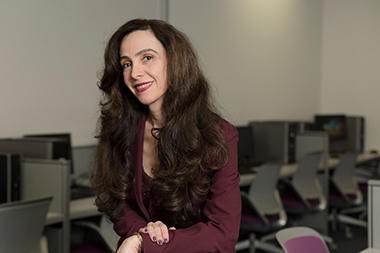Link between NY cancer diagnoses and Chernobyl disaster
 |
|
Roxana Moslehi, associate professor in the School of Public Health, was asked by oncologists in NYC to investigate the potential causes of an ultra-rare cancer. |
ALBANY, N.Y. (January 23, 2018) – A School of Public Health professor has found a potential link between a cluster of cancer diagnoses in New York and the 1986 Chernobyl Nuclear Disaster.
When four ophthalmology and oncology practices in New York City diagnosed 10 patients with ultra-rare vitreoretinal lymphoma (VRL) during a four-year period, the doctors’ curiosity piqued: VRL is an unusual presentation of the already-rare primary central nervous system lymphoma where the cancer occurs in the eyes. Only about one quarter of patients suffering from primary center nervous system lymphoma, a non-Hodgkins lymphoma in the brain or spine, develop vitreoretinal lymphoma.
Considering the uniqueness of the situation, the doctors reached out to Roxana Moslehi, associate professor and renowned genetic epidemiologist/cancer researcher, to clarify the epidemiology of VRL and consider potential causes or risk factors among their 10 cases.
Upon determining the overall incidence rates of VRL in the US and in New York State (NYS), the team first confirmed that the 10 NYC cases constituted a “cluster,” or an unusually high incidence of a disease occurring in close proximity both in time and location.
The team looked at characteristics including but not limited to:
- Age at diagnosis
- Racial/ethnic background
- Past and prior residences
- Clinical characteristics of their diseases
- Other medical conditions
- Family history
The team found that six of them had one major thing in common: they had all lived in regions close to the Chernobyl nuclear power facility at the time of the notorious radioactive disaster. Though the number of immediate deaths related to the accident is believed by many experts to be under 50, experts also acknowledge that potential long-term effects of radiation exposure is not concretely known.
Of the six New York VRL patients who lived near the power facility at the time of the accident, four reported living in the Ukraine, one in Poland, and one in Moldova. The median time from the accident to diagnosis was 26 years, and there were no other medical conditions unique to this group of six patients when compared to the other four.
“As soon as I was contacted by Dr. Sanford Kempin at Mount Sinai Beth Israel Comprehensive Cancer Center, I was immediately interested in helping because the cause of VRL to date is unknown,” said Moslehi.
“Any clues pointing to risk factors or causes we could learn from studying these 10 cases could be valuable in understanding the biologic mechanisms that lead to this type of cancer, and possibly to other forms of lymphoma as well,” Moslehi continued.
In addition to looking at characteristics of the 10 patients, the group calculated rates of VRL in 13 areas from 1992 to 2014 using data from the National Cancer Institute’s Surveillance, Epidemiology and End Results (SEER) Program. SEER rates are representative of overall rates for the US. Because NYS data is not reported to SEER, they also utilized the New York State Cancer Registry Database.
The team’s findings through demonstrate the true rarity of VRL: During the 22-year period between 1992 and 2014, just 20 people were diagnosed in the 13 SEER areas; a significantly lower incidence than the 10 cases in four years in New York City. The team estimated the number of expected cases as approximately three in four years for the entire state of New York.
“Though our results do not definitively confirm that exposure to nuclear radiation is a cause of VRL, our findings warrant further research on the role of radiation alone and/or in combination with genetic factors and gene-environment interactions,” said Moslehi.
According to Moslehi, the findings also underscore the importance of establishing and maintaining registries in a multi-center collaborative manner for rare cancers such as VRL, so that these types of etiologic investigations can occur.
The full paper can be downloaded here.
![]() For more news, subscribe to UAlbany's RSS headline feeds
For more news, subscribe to UAlbany's RSS headline feeds
A comprehensive public research university, the University at Albany-SUNY offers more than 120 undergraduate majors and minors and 125 master's, doctoral and graduate certificate programs. UAlbany is a leader among all New York State colleges and universities in such diverse fields as atmospheric and environmental sciences, business, education, public health,health sciences, criminal justice, emergency preparedness, engineering and applied sciences, informatics, public administration, social welfare and sociology, taught by an extensive roster of faculty experts. It also offers expanded academic and research opportunities for students through an affiliation with Albany Law School. With a curriculum enhanced by 600 study-abroad opportunities, UAlbany launches great careers.


